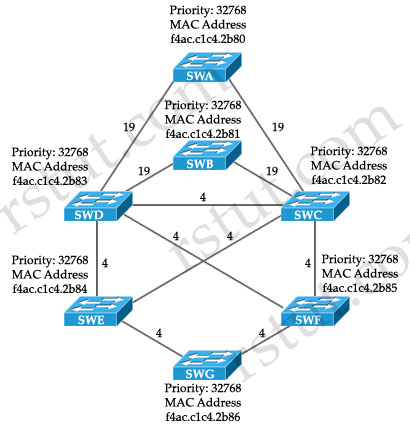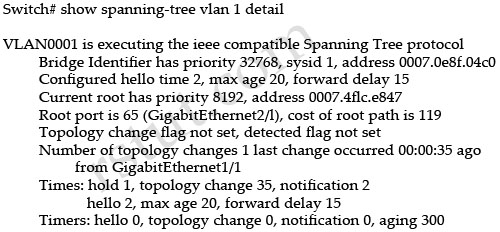Question 1
Refer to the exhibit.

All switches have default bridge priorities, and originate BPDUs with MAC addresses as indicated. The numbers shown are STP link metrics. Which two ports are in blocking state after STP converges? (Choose two)
A. the port on switch SWD that connects to switch SWE
B. the port on switch SWF that connects to switch SWG
C. the port on switch SWD that connects to switch SWC
D. the port on switch SWB that connects to switch SWD
B. the port on switch SWF that connects to switch SWG
C. the port on switch SWD that connects to switch SWC
D. the port on switch SWB that connects to switch SWD
Answer: C D
Question 2
Refer to the exhibit.

All switches have default bridge priorities, and originate BPDUs with MAC addresses as indicated. The numbers shown are STP link metrics. Which two ports are forwarding traffic after STP converges? (Choose two)
A. The port connecting switch SWD with switch SWE
B. The port connecting switch SWG with switch SWF
C. The port connecting switch SWC with switch SWE
D. The port connecting switch SWB with switch SWC
B. The port connecting switch SWG with switch SWF
C. The port connecting switch SWC with switch SWE
D. The port connecting switch SWB with switch SWC
Answer: C D
Question 3
Refer to the exhibit.

Which two statements about the output are true? (Choose two)
A. 802.1D spanning tree is being used.
B. Setting the priority of this switch to 0 for VLAN1 would cause it to become the new root.
C. The hello, Max-age, and forward delay timers are not set to their default values.
D. Spanning-tree PortFast is enabled on GigabitEthernet1/1.
B. Setting the priority of this switch to 0 for VLAN1 would cause it to become the new root.
C. The hello, Max-age, and forward delay timers are not set to their default values.
D. Spanning-tree PortFast is enabled on GigabitEthernet1/1.
Answer: A B
Question 4
Which statement is true regarding UDLD and STP timers?
A. The UDLD message timer should be two times the STP forward delay to prevent loops.
B. UDLD and STP are unrelated features, and there is no relation between the timers.
C. The timers need to be synced by using the spanning-tree udld-sync command.
D. The timers should be set in such a way that UDLD is detected before the STP forward delay expires.
B. UDLD and STP are unrelated features, and there is no relation between the timers.
C. The timers need to be synced by using the spanning-tree udld-sync command.
D. The timers should be set in such a way that UDLD is detected before the STP forward delay expires.
Answer: D
Question 5
Refer to the exhibit.

Which technology does the use of bi-directional BPDUs on all ports in the topology support?
A. RSTP
B. MST
C. Bridge Assurance
D. Loop Guard
E. Root Guard
F. UDLD
B. MST
C. Bridge Assurance
D. Loop Guard
E. Root Guard
F. UDLD
Answer: C
Question 6
Refer to the exhibit.

Which two statements are true about the displayed STP state? (Choose two)
A. The STP version configured on the switch is IEEE 802.1w.
B. Port-channel 1 is flapping and the last flap occurred 1 minute and 17 seconds ago.
C. The switch does not have PortFast configured on Gi0/15.
D. BPDUs with the TCN bit set are transmitted over port channel 1.
B. Port-channel 1 is flapping and the last flap occurred 1 minute and 17 seconds ago.
C. The switch does not have PortFast configured on Gi0/15.
D. BPDUs with the TCN bit set are transmitted over port channel 1.
Answer: C D
Question 7
Refer to the exhibit.

While troubleshooting high CPU utilization on one of your Cisco Catalyst switches, you find that the issue is due to excessive flooding that is caused by STP. What can you do to prevent this issue from happening again?
A. Disable STP completely on the switch.
B. Change the STP version to RSTP.
C. Configure PortFast on port-channel 1.
D. Configure UplinkFast on the switch.
E. Configure PortFast on interface Gi0/15.
B. Change the STP version to RSTP.
C. Configure PortFast on port-channel 1.
D. Configure UplinkFast on the switch.
E. Configure PortFast on interface Gi0/15.
Answer: E
Question 8
Which two statements are true about RSTP? (Choose two)
A. By default, RSTP uses a separate TCN BPDU when interoperating with 802.1D switches.
B. By default, RSTP does not use a separate TCN BPDU when interoperating with 802.1D switches.
C. If a designated port receives an inferior BPDU, it immediately triggers a reconfiguration.
D. By default, RSTP uses the topology change TC flag.
E. If a port receives a superior BPDU, it immediately replies with its own information, and no reconfiguration is triggered.
B. By default, RSTP does not use a separate TCN BPDU when interoperating with 802.1D switches.
C. If a designated port receives an inferior BPDU, it immediately triggers a reconfiguration.
D. By default, RSTP uses the topology change TC flag.
E. If a port receives a superior BPDU, it immediately replies with its own information, and no reconfiguration is triggered.
Answer: B D
Sign up here with your email

ConversionConversion EmoticonEmoticon